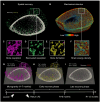Tracking of spaceflight-induced bone remodeling reveals a limited time frame for recovery of resorption sites in humans
- PMID: 39705358
- PMCID: PMC11661419
- DOI: 10.1126/sciadv.adq3632
Tracking of spaceflight-induced bone remodeling reveals a limited time frame for recovery of resorption sites in humans
Abstract
Mechanical unloading causes bone loss, but it remains unclear whether disuse-induced changes to bone microstructure are permanent or can be recovered upon reloading. We examined bone loss and recovery in 17 astronauts using time-lapsed high-resolution peripheral quantitative computed tomography and biochemical markers to determine whether disuse-induced changes are permanent. During 6 months in microgravity, resorption was threefold higher than formation. Upon return to Earth, targeted bone formation occurred in high mechanical strain areas, with 31.8% of bone formed in the first 6 months after flight at sites resorbed during spaceflight, significantly higher than the 2.7% observed 6 to 12 months after return. Limited bone recovery at resorption sites after 6 months on Earth indicates a restricted window for reactivating bone remodeling factors in humans. Incomplete skeletal recovery may arise from these arrested remodeling sites, representing potential targets for new interventions, thus providing means to counteract this long-term health risk for astronauts.
Figures




References
-
- Frost H. M., The mechanostat: A proposed pathogenic mechanism of osteoporoses and the bone mass effects of mechanical and nonmechanical agents. Bone Miner. 2, 73–85 (1987). - PubMed
-
- Frost H. M., Bone’s mechanostat: A 2003 update. Anat. Rec. A Discov. Mol. Cell. Evol. Biol. 275, 1081–1101 (2003). - PubMed
-
- Everts V., Delaissé J. M., Korper W., Jansen D. C., Tigchelaar-Gutter W., Saftig P., Beertsen W., The bone lining cell: Its role in cleaning Howship’s lacunae and initiating bone formation. J. Bone Miner. Res. 17, 77–90 (2002). - PubMed
MeSH terms
Substances
LinkOut - more resources
Full Text Sources

